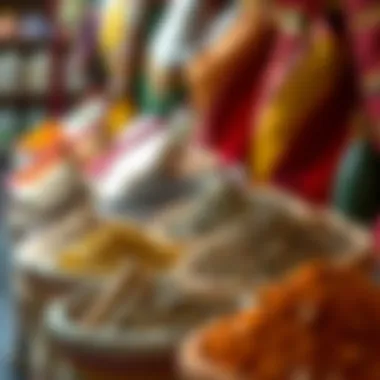Exploring Dubai's Spice Souk: Hours and Highlights


Intro
The Spice Souk in Dubai is not merely a shopping destination; it's a vibrant tapestry of sensory experiences. Strolling through its narrow alleys, one is enveloped by the rich scents of saffron, cardamom, and nutmeg, each corner revealing stalls brimming with colorful spices and traditional goods. More than just a market, the Spice Souk embodies a piece of Dubai's history, connecting visitors and locals alike with the city’s trading roots.
Understanding the allure of the Spice Souk goes beyond its fragrant offerings. It invites a deeper exploration of its operational hours, the historical context of trade in the region, and the various products that can be found within its bustling atmosphere. This guide aims to provide a comprehensive view of the Spice Souk, ensuring that when you plan your visit, you not only take in the sights and smells but understand the rich heritage and cultural significance behind this iconic market.
The Spice Souk's transition in recent years also plays an essential role, as it adapts to both the needs of tourists and the expectations of the local populace. As we dive into the details, including what's currently trending in the market, practical tips for navigating your visit, and what to keep an eye out for, you'll find yourself better equipped to appreciate everything this esteemed marketplace has to offer.
Overview of the Spice Souk
The Spice Souk in Dubai is not just a market; it's a vibrant tapestry of history and culture woven together by the spices that have been traded here for generations. This area captures the essence of Dubai's trading roots and serves as a reminder of the rich heritage associated with the spice trade that has flurished for centuries. To understand the Spice Souk is to delve into the past, feel the pulse of the present, and anticipate the future of culinary experiences.
Historical Background
Originally, the Spice Souk was a bustling hub along ancient trade routes, where merchants from different parts of the world would bring their unique spices. Located close to the Dubai Creek, the area provided easy access for ships and traders, establishing it as a center for commerce. The Souk's architecture still reflects those early influences, with traditional wooden structures and narrow alleyways that evoke a sense of nostalgia. The history here is palpable; one can almost hear the echo of traders bargaining over vibrant saffron and fragrant cardamom.
Cultural Significance
The cultural significance of the Spice Souk is multifaceted. For locals, it represents a source of pride, showcasing the culinary diversity that spices can enhance. Visitors come not just to shop but to experience the warm exchanges with merchants who often share stories embedded in their family traditions. Instruments like the duff drum may even make an appearance during festive periods, enriching the Souk with sounds that have reverberated through the ages.
- The use of spices here transcends mere culinary applications; they symbolize relationships, trade connections, and shared histories.
- Whether it’s the somber tones of a spice merchant sharing the tale of his grandfather’s first sale or the vibrant colors of freshly ground spices inviting tourists to partake in a global heritage, the cultural layer deepens with every visit.
Geographical Context
Geographically, the Spice Souk sits in a unique location that has played a crucial role in its prominence. Positioned near the Dubai Creek, it acts as a natural conduit for both sea and land trade. Over the years, various other markets have sprung up nearby, creating a thriving economic area, uniting diverse aspects of Dubai’s culture. This prime location also means it attracts foot traffic from both locals and tourists, which adds to its lively, bustling environment.
- The proximity to the Gold Souk, for instance, allows visitors to make a single trip memorable, rich with color and flavor on one side and glimmer on the other.
- Consequently, one can explore a harmonious blend of different markets, enriching the experience beyond just spices, as they discover the many facets of Dubai’s marketplace.
"To walk through the Spice Souk is to understand not just the ingredients but the stories that flavor life in Dubai."
The Spice Souk serves not only as a key shopping destination but also as a living museum of the culinary arts. Each spice carries history, each merchant embodies legacy, and every visit broadens one’s understanding of Dubai's immeasurable tapestry of culture.
Opening Hours of the Spice Souk
The opening hours of the Spice Souk, a colorful representation of Dubai's bustling culture, are essential for anyone looking to explore its myriad offerings. Knowing when the souk operates can greatly influence your visit and the overall experience. With the souk being a lively hub filled with spices, herbs, and traditional products, timing can dictate the level of crowd you encounter and the availability of certain items.
Being well-informed about the souk's hours can help visitors plan effectively, ensuring that you catch all the vibrant activities and make the most of your time. After all, nobody wants to arrive only to find the doors closed and the enticing scents just out of reach.
Daily Hours
Typically, the Spice Souk welcomes guests every day from 9 AM to 9 PM. This schedule makes it accessible for both early birds and those who prefer a leisurely evening stroll. A significant buzz fills the air, especially in the late afternoons. If you're considering a visit, arriving during these peak hours can offer a more vibrant shopping experience, with local vendors showcasing their freshest goods and engaging in the delightful art of bargaining.
However, it’s wise to remember that the souk can feel quite alive around lunchtime. Locals often take to the streets, emerging from shops to grab a bite or enjoy a chat, which may lead to an increase in foot traffic. Timing it right is half the fun — visit either early or late in the day to enjoy a more relaxed atmosphere.


Seasonal Variations
During various seasons, the Spice Souk’s hours can shift subtly to accommodate different routines and events. For instance, in the hot summer months, many shops may open later in the day, extending their hours until later in the evening to catch the cooler temperatures. Conversely, during the cooler months, the souk often attracts more visitors, prompting some merchants to open their stall doors earlier.
Additionally, it's important to note any special sales or events that might happen throughout the year. The souk can introduce seasonal specials, so keeping an eye on local announcements or social media updates can reveal additional opportunities to visit.
Public Holidays
Public holidays in Dubai can dramatically affect the Spice Souk's operating hours. On national holidays such as Eid or the UAE National Day, you might find the souk closed or operating on reduced hours. On the other hand, these days can provide unique insights into local culture and offer a chance to experience festive decorations and celebrations.
To ensure you don’t miss out, consider checking the official Dubai tourism website or local news outlets for updates on any changes to the souk's schedule during these times. It’s always best to confirm before embarking on your flavorful journey through this aromatic paradise.
Knowing the Spice Souk’s hours can help you dodge crowds and shop like a local, making it an experience worth savoring.
Exploring the Spice Souk
The Spice Souk is not just a marketplace; it’s a journey through flavors and aromas that define both local culture and global influences. This bustling hub, nestled in the heart of Dubai, offers an immersive experience that truly reflects the essence of the region. Exploring the Spice Souk presents a unique opportunity for visitors to engage with the vibrant tapestry of spices, herbs, and traditional products that have contributed to the culinary heritage of Dubai and beyond.
Types of Spices Available
When you step into the Spice Souk, your senses are immediately greeted by an intoxicating blend of scents. The vast array of spices available here is nothing short of astonishing.
- Saffron: Known as the gold of spices, saffron not only enhances the flavor of dishes but also infuses a gorgeous hue. It’s often used in biryanis and desserts.
- Turmeric: A staple in Middle Eastern and Indian kitchens, turmeric adds a warm, earthy flavor to dishes and is celebrated for its health benefits.
- Cardamom: This aromatic spice is integral in both savory and sweet preparations, perfect for chai or even rice dishes.
- Sumac: Offering a tart flavor reminiscent of lemon, this spice is a common addition to dressings and dips.
These spices are often sold in vibrant sacks or jars, each one more eye-catching than the last. They are fundamental not just in cooking but also in the cultural exchanges that have shaped the community’s culinary fabric.
Herbs and Essentials
Accompanying the spices you’ll find an equally enchanting selection of herbs and essentials. These offerings form the backbone of traditional cooking practices in the region. Herbs like za'atar—a mix of thyme, oregano, and sesame seeds—are popular for their distinctive taste and versatility. Dried mint also finds its place in local dishes, providing a refreshing contrast to many recipes.
Moreover, essential products such as rose water and orange blossom water are staples in both culinary and beauty routines. Used to flavor pastries and beverages, these floral essences capture the essence of Middle Eastern cuisine, revealing layers of tradition that have been passed down through generations.
Traditional Products
The Spice Souk is not limited to just spices and herbs; it offers a range of traditional products that reflect the craft and culture of the local community.
- Incense and Bakhoor: These aromatic wonders are commonly used in Emirati households, creating a warm and inviting atmosphere.
- Local Honey: Renowned for its rich flavor, local honey varieties are often infused with herbs and spices, making them a sought-after product for both locals and tourists.
- Dried Fruit: Products like dates and apricots are in abundance, reflecting not just the local agricultural bounty but also the import of ancient trade routes. They are perfect for snacking or as a natural sweetener in various dishes.
Visiting the Spice Souk offers a glimpse into the daily life of a resident while providing a comprehensive understanding of the culinary practices rooted deep in the culture.
"The Spice Souk is a living memory of the Arabian heritage, where flavors converge and stories unfold."
In summary, Exploring the Spice Souk reveals a depth of cultural significance, showcasing how spices, herbs, and traditional products weave into the very fabric of Dubai’s identity. Engaging with these elements not only enhances your culinary knowledge but also creates meaningful connections to the local lifestyle, enriching any visit to this iconic market.
Shopping Etiquette at the Spice Souk


Shopping at the Spice Souk isn’t just about purchasing spices; it’s a delightful dance steeped in tradition and respect. Understanding and embracing the etiquette of this bustling bazaar enhances not only your buying experience but also fosters goodwill with local merchants. This bustling marketplace thrives on interactions, and knowing the unwritten rules will ease your path and possibly get you a better deal.
Bargaining Tips
Bargaining at the Spice Souk can feel like a rite of passage for many tourists. Here, haggling is expected, a cultural norm rather than an annoyance. To make the most of this invigorating experience, consider these pointers:
- Do Your Homework: Before you step foot in a shop, familiarize yourself with the usual prices of spices and herbal products. This preparatory step can give you an edge while negotiating.
- Start Low: Aim to offer about 20-30% lower than the asking price. This opens the door for negotiation and creates a more jovial atmosphere.
- Stay Polite and Cheerful: A smile and a good attitude can go a long way. If a seller sees you’re enjoying the interaction, they may be more willing to give you a deal.
- Be Prepared to Walk Away: If you feel like the price is not right, don't hesitate to kindly walk out. This technique often leads sellers to reconsider their price as they see you leaving.
- Cash is King: While some stalls accept credit cards, cash is preferred, especially in small transactions. Having dirhams on hand can smooth out the negotiation process.
These tips will equip you with the tools to navigate through price discussions without tension, ensuring both parties leave satisfied.
Respecting Local Customs
Respecting local customs is paramount in an environment like the Spice Souk. It’s not just about following rules; it’s about honoring a culture that has thrived for centuries.
- Dress Modestly: Though Dubai is quite liberal compared to other places in the region, dressing modestly shows respect for the local culture. This simple act contributes positively to your experience.
- Ask Before Taking Photos: Many vendors are happy to let you snap photos of their colorful displays, but it's best practice to ask first. This shows respect for their merchandise and personal space.
- Exchange Greetings: A simple "Salam Alaikum" can work wonders. Greeting vendors in their language can build rapport and may even yield a friendlier atmosphere during the transaction.
- Observe the Flow: When in the midst of shopping, take a moment to observe how locals interact. This can provide further clues on how to navigate and engage respectfully with sellers.
Adhering to these customs not only enhances your experience but also leaves a positive impression, blending your journey with the rich tradition of Dubai's spice merchants.
"Shopping here is as much about the connection to the culture as it is about the spices themselves."
In sum, knowing the shopping etiquette at the Spice Souk enriches your journey and reflects a thoughtful approach to engaging with the local community. Such interactions can lead to memorable experiences and delightful discoveries amid the scents and sights that this unique market has to offer.
Visiting Logistics
When planning a visit to the Spice Souk, understanding the logistics is pivotal. It not only helps you navigate through one of Dubai's most iconic markets but also enhances your overall experience. From transport options to accessibility routes, and even nearby attractions, there’s a wealth of information that can enrich your journey.
Transport Options
Getting to the Spice Souk doesn’t have to be a cumbersome task. Several means of transport are at your disposal:
- Metro: The Dubai Metro is a convenient choice. You can hop on the Red Line and disembark at Al Ras Station. From there, it’s just a short stroll to the souk.
- Water Taxi: For a more scenic route, consider taking a water taxi or an abra ride across the Dubai Creek. This traditional method offers a unique perspective of the city.
- Bus Services: Numerous bus routes connect various parts of Dubai to the Spice Souk. Buses are usually economical and run frequently.
- Taxi Services: Taxis are widely available and can take you directly to the souk’s entrance, which is a straightforward option if you’re traveling in a group or with luggage.
Each option has its pros and cons, but the choice largely depends on your specific circumstances, such as timing and comfort preferences.
Walking Routes and Accessibility
The Spice Souk is nestled in the heart of the old city, making walking an appealing option. Here’s how to navigate:
- Immediate Surroundings: The souk's pedestrian-friendly layout makes it easy to wander. Streets are bustling, alive with the scent of spices and sounds of bargaining.
- Accessibility for All: While some areas do present challenges, recent efforts have been made to ensure accessibility for all visitors. Ramps and designated paths help those with mobility issues.
- Guided Tours: Opting for a guided walking tour can further enhance your experience, as knowledgeable guides can provide insights you might otherwise miss.
Nearby Attractions
While the Spice Souk should be the main attraction, the neighborhood is teeming with other sites worth a visit:


- Gold Souk: Just a stone's throw away, and famous for its dazzling display of gold jewelry, it’s worth checking out if you’re in the area.
- Dubai Creek: A short walk will lead you to the waterfront, where you can enjoy a serene view of the bustling creek.
- Dubai Museum: Located at Al Fahidi Fort, this museum illustrates Dubai's transformation from a humble fishing village to a global hub.
- Heritage House: Experience traditional Emirati architecture and lifestyle within this charming, restored home.
These attractions can transform a simple visit to the Spice Souk into a day rich with culture and exploration.
Pro tip: Always keep an eye on your belongings while wandering through the souk; it’s bustling, and a little awareness goes a long way to enhance your experience.
Sustainability and the Spice Souk
Understanding the Sustainability of the Spice Souk in Dubai is a significant aspect that speaks volumes about not just the marketplace itself, but also the broader context of environmental stewardship and cultural preservation. In recent years, consumers have become increasingly aware of the need for sustainable practices in all aspects of life. The Spice Souk offers a unique opportunity to reflect on these practices as they pertain specifically to the sourcing and selling of spices and herbs.
The implications of sustainability at the Spice Souk reach beyond mere profitability; they touch on ethical considerations that resonate with today's conscientious visitor. For instance, supporting sustainable and eco-friendly sourcing of spices minimizes the environmental footprint while ensuring that local ecosystems are preserved. This practice is not merely a trend but a responsibility towards future generations.
Eco-friendly Practices
The Spice Souk has started to embrace eco-friendly practices widely. Vendors are becoming more aware of their impact on the environment and are adopting methods that promote sustainability. For example, many sellers now focus on zero-waste initiatives by using biodegradable packaging materials for their products. This change is vital as it reduces plastic waste, which has long been a global concern.
Additionally, efforts are being made to source spices from farms that prioritize organic cultivation methods. These practices not only support healthier soil and biodiversity but also provide customers with high-quality products devoid of harmful chemicals. The rise of organic spices is a clear indicator that consumers are willing to pay a little extra for a product that is both good for their health and beneficial for the planet.
Moreover, several shops within the souk have taken to offering bulk purchasing options. This serves a dual purpose: it reduces packaging waste and allows shoppers to buy only what they need, encouraging mindful consumption.
A quick review of local initiatives shows that many vendors actively participate in community programs aimed at educating the public about sustainability. Vendors partner with local organizations to host community workshops that bring awareness to sustainable farming and the importance of native spices. Such events not only enhance the souk’s reputation but also engage visitors in meaningful conversations about environmental responsibility.
Support for Local Farmers
Sustaining the Spice Souk goes hand-in-hand with strengthening the livelihoods of local farmers. By prioritizing partnerships with local producers, the souk helps ensure that the economic benefits of spice sales remain within the community. Local farmers are often more committed to sustainable practices, as they directly bear the consequences of environmental degradation quite literally in their backyards.
Supporting local farmers creates a ripple effect that economic prosperity. When you buy spices from local vendors, you’re not just purchasing a product; you're investing in the community’s well-being and, ultimately, in the preservation of local traditions.
Vendors at the Spice Souk frequently source their spices from nearby farms, bolstering local agriculture and reducing transportation emissions. This not only enhances the freshness of the spices available but also builds robust supply chains that contribute to food security in the region. Given the significance of agriculture in the UAE, the souk’s commitment to local farmers paints a bright picture of sustainability in urban marketplaces.
In summary, the sustainability initiatives at the Spice Souk reflect a thoughtful approach to maintaining cultural and environmental health. It stands not only as a bustling marketplace but also as a model for sustainability that aligns economic growth with community and ecological responsibility.
The End on the Spice Souk Experience
The Spice Souk in Dubai is not just a marketplace; it encapsulates the essence of a cultural journey that resonates deeply with both expatriates and tourists. At its core, the souk is a tangible reflection of the city's historical trade routes and culinary heritage. Understanding this aspect is essential. It allows visitors to appreciate the vibrant tapestry of flavors and aromas that fill the air.
The Role of Spices in Everyday Life
Spices hold a pivotal role in numerous cultures globally, and in Dubai, they serve more than just culinary purposes. They are a symbol of hospitality and a means to connect with both the community and one's heritage. In daily life, spice contributes to the nutritional value and flavor profiles of meals, turning an ordinary dish into an extraordinary experience. For instance, the use of cardamom in coffee not only enhances the beverage but also reflects the local custom of hospitality when welcoming guests into one's home.
In addition, spices carry health benefits, often being used in traditional remedies to cure common ailments. An example includes turmeric, renowned for its anti-inflammatory properties, frequently integrated into both meals and natural remedies. Understanding these elements helps visitors see the significance of spices beyond mere ingredients; they are vital to the cultural identity of the community.
Final Thoughts for Visitors
As you prepare for your visit to the Spice Souk, it’s important to carry an attitude of both curiosity and respect. The souk represents a bustling intersection of tradition and modernity, where the old-world charm harmonizes with the vibrancy of contemporary Dubai. Aim to explore each stall, engage with the vendors, and perhaps even indulge in a bit of bargaining, which is often considered a friendly and expected practice.
Ultimately, the experience of wandering through the narrow alleys lined with jars full of exotic spices and fragrant herbs is more than a shopping trip; it’s an immersion into a world steeped in history, flavor, and community. Taking the time to explore this gem in the heart of Dubai will not only enhance your culinary repertoire but also deepen your understanding of the cultural dynamics that make this city truly unique.
"The Spice Souk is not merely a place to shop; it's a cultural epicenter where stories are shared through the scents and flavors of its diverse spices."
By visiting, you’re not just a passerby; you become part of a cherished tradition that has enriched lives across generations. So, when you set foot into the Souk, remember that each spice tells a story. Embrace these narratives, and carry them home with you.











